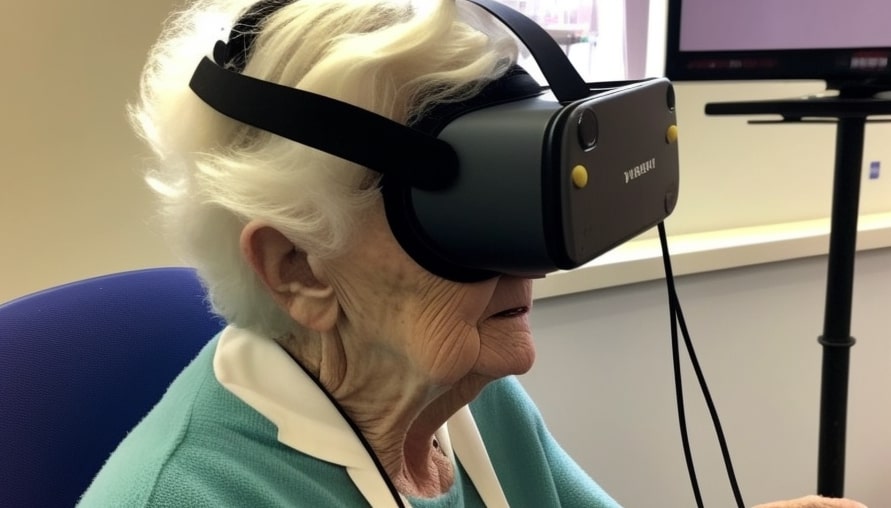Elderly people are becoming older quickly, and this includes people whose everyday duties are made more difficult by cognitive impairment.
The autonomy of these old people and their carers would significantly benefit from developing therapies that delay cognitive decline. Virtual reality (VR) is an immersive, interactive, and real-time simulation human-computer interface that has the potential to help with cognitive function.
This literature review covers the elements of immersive VR, including its prospects and limits, that are of specific relevance for boosting cognition in old.
Aspects in which VR contributes:-
First, the tremendous degree of flexibility offered by VR enables safe, individualized training for isolated activities and potentially dangerous situations. Second, VR’s dynamic and real-time performance feedback offers carers a labor-intensive tool in elderly care.
Third, the collection of high-resolution data makes it possible to detect minute alterations over time, which is important for determining the type and severity of cognitive alterations in the elderly, particularly those suffering from dementia. Fourth, virtual reality immersion has been linked to cybersickness.
Finally, since VR is immersive, it allows users to perceive and express their emotions as well as their motor and sensory activities. Older subjects are observed to be less likely to learn emotionally and to rely more heavily on multisensory integration. Moreover, they experience high levels of flow, motivation, and presence in VR setups. The studies that are currently available are limited in size and have yet to be reproduced, despite the apparent potential of immersive VR.
Another obstacle to implementation is the elderly’s and healthcare workers’ lack of digital literacy. Hence, VR may be a particularly effective tool for training cognition in elderly individuals, even though replication of outcomes and standardization of VR interventions are needed before it can be employed in standard care.
VR is a way to escape the real world into something more fantastic. It has the potential to be the most social technology of all time
Why VR becomes more Important in issues related to the mind?

While many Europeans are still healthy as they age, an increasing number of them are also suffering from age-related disorders, as well as cognitive and physical decline and physical decline.
Dementia is, in fact, the second most common reason for disability in people over 70. Dementia affects a broad range of cognitive skills, including long-term memory, executive functioning, and spatial orientation. The performance of activities of daily living (ADLs) is negatively impacted by the impairment of these capabilities.
Lower quality of life has been linked to the subsequent decline in autonomy. The cognitive deterioration that older people undergo has not yet been completely stopped by any intervention.
Nonetheless, it has been demonstrated that cognitive training can slightly enhance overall cognition in healthy aged as well as dementia patients. Furthermore, both healthy [16–19] and cognitively impaired elderly people have responded favorably to physical therapies like weight training, either by themselves or in conjunction with cognitive ones. However, gains are sometimes modest and not all studies uncover a beneficial effect.
An innovative and promising approach to improve cognitive functioning is immersive virtual reality (VR). Burdea and Coiffet succinctly describe virtual reality as “a high-end user-computer interface involving real-time stimulation and interactions of an embedded subject through multiple sensorial channels (visual and auditory, sometimes haptic, even smell and taste if possible), based on a synthetic environment.”
VR Features
The incredible thing about the technology is that you feel like you’re actually present in another place with other people. People who try it say it’s different from anything they’ve ever experienced in their lives.”
VR offers a variety of features that allow several pretty unique options in comparison to conventional computer-based gadgets, but it also has a number of limits.
VR Allows for a Highly Flexible Training Environment
The VR environment is very adaptable and enables training in environments that would be either too risky or impractical in real life. Before tackling a task in its full complexity, it enables the practice of the work’s component elements. For instance, a double-blind, randomized controlled trial showed that individual parts of walking, such as weight shifting and stepping, can be later trained and improved in persons with hemiparetic stroke.
VR Has the Potential to Decrease Dependence on Care Professionals
Rehabilitation and other training programs can take a lot of time for older people and their informal carers since they require seeing a professional, and they need a lot of work from care providers because each person needs individualized instruction and assistance. Yang et alrandomized’s controlled study. This demonstrates that senior VR therapy within a community context is actually possible and successful.
VR Allows for the Gathering of Rich Data
The ability to collect a wide range of data with a high temporal resolution made possible by virtual reality (VR) makes it easier to spot small differences between and among people. For instance, kinematic information such as mass trajectories, stride length, and step breadth can be collected.
Conclusion:-

Due to its special qualities, immersive VR has a lot of potential for senior cognitive training. Given the diversity of the older population and the demand for secure training environments, it can be customized to the individual. Furthermore, the high level of automation in VR may reduce the load that traditional interventions place on carers and medical professionals while fostering a greater sense of autonomy in the aged.
Moreover, VR offers a very rich dataset, permits precise tracking of development, and enables fine-tuning of the treatment’s focus. Although the majority of research does not focus on the elderly, immersive VR training strategies often provide better training outcomes than other interventions, and the involvement of multiple senses and strong emotional saliency are likely to be the underlying causes.
Overall, immersive VR seems to foster greater flow, motivation, and pleasure than non-immersive interventions, which can be crucial for senior participants’ commitment to therapies. The realism of immersive VR also facilitates the transfer of learned abilities from the Virtual environment to the real world.


